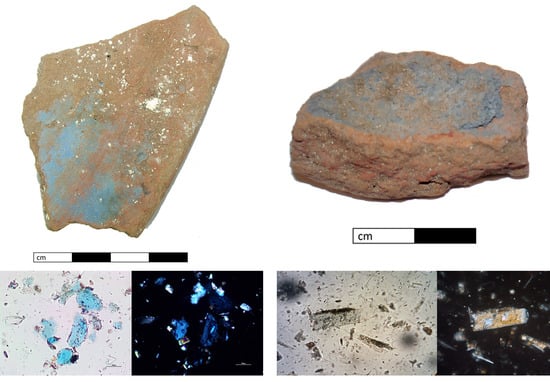Multi-Scale Characterization of Unusual Green and Blue Pigments from the Pharaonic Town of Amara West, Nubia
Abstract
:1. Introduction
Amara West
2. Materials and Methods
2.1. Sampling from Site
2.2. Instrumentation and Analytical Techniques
2.2.1. Polarized Light Microscopy (PLM)
2.2.2. Attenuated Total Reflection Fourier Transform Infrared Spectroscopy (ATR-FTIR)
2.2.3. Scanning Electron Microscope Energy-Dispersive X-ray Spectroscopy (SEM-EDS)
2.2.4. Powder X-ray Diffraction (pXRD)
3. Results
3.1. Blue Pigments
3.2. Green Pigments
4. Discussion
Author Contributions
Funding
Institutional Review Board Statement
Informed Consent Statement
Data Availability Statement
Acknowledgments
Conflicts of Interest
References
- Ambers, J. Pigments. In The Nebamun wall paintings: Conservation, scientific analysis and display at the British Museum; Middleton, A., Uprichard, K., Eds.; Archetype in Association with the British Museum: London, UK, 2008; pp. 31–40. [Google Scholar]
- El Goresy, A. Polychromatic Wall Painting Decorations in Monuments of Pharaonic Egypt: Compositions, Chronology and Painting Techniques. In The Wall Paintings of Thera, Proceedings of the First International Symposium Thera, Hellas, 30 August–4 September 1997; Sherratt, S., Ed.; Thera Foundation: Athens, Greece, 2000; pp. 49–70. [Google Scholar]
- McCarthy, B. Technical Analysis of Reds and Yellows in the Tomb of Suemniwet, Theban Tomb 92. In Colour and Painting in Ancient Egypt; Davies, W.V., Ed.; British Museum Press: London, UK, 2001; pp. 17–21. [Google Scholar]
- Stulik, D.; Porta, E.; Palet, A. Analyses of Pigments, Binding Media and Varnishes. In Art and eternity: The Nefertari Wall Paintings Conservation Project 1986–1992; Corzo, M.A., Afshar, M., Eds.; Getty Conservation Institute: Santa Monica, CA, USA, 1993; pp. 55–65. [Google Scholar]
- Uda, M. In Situ Characterization of Ancient Plaster and Pigments on Tomb Walls in Egypt Using Energy Dispersive X-ray Diffraction and Fluorescence. Nucl. Instrum. Methods Phys. Res. Sect. B Beam Interact. Mater. At. 2004, 226, 75–82. [Google Scholar] [CrossRef]
- Green, L. Recent Analysis of Pigments from Ancient Egyptian Artefacts. In Conservation in Ancient Egyptian Collections; Brown, C.E., Macalister, F., Wright, M.M., Eds.; Archetype: London, UK, 1995; pp. 85–91. [Google Scholar]
- Pagès-Camagna, S.; Guichard, H. Egyptian Colours and Pigments in French Collections: Physicochemical Analyses on 300 Objects. In Decorated Surfaces on Ancient Egyptian Objects: Technology, Deterioration and Conservation, Proceedings of a Conference held in Cambridge, UK on 7–8 September 2007; Dawson, J., Rozeik, C., Wright, M.M., Eds.; Archetype in Association with the Fitzwilliam Museum and Icon Archaeology Group: London, UK, 2010; pp. 25–31. [Google Scholar]
- Scott, D.A. A Review of Ancient Egyptian Pigments and Cosmetics. Stud. Conserv. 2016, 61, 185–202. [Google Scholar] [CrossRef]
- David, R.; Edwards, H.G.M.; Farwell, D.W.; De Faria, D.L.A. Raman Spectroscopic Analysis of Ancient Egyptian Pigments. Archaeometry 2001, 43, 461–473. [Google Scholar] [CrossRef]
- Hatton, G.D.; Shortland, A.J.; Tite, M.S. The Production Technology of Egyptian Blue and Green Frits from Second Millennium BC Egypt and Mesopotamia. J. Archaeol. Sci. 2008, 35, 1591–1604. [Google Scholar] [CrossRef]
- Weatherhead, F. Wall-Paintings from the King’s House at Amarna. J. Egypt. Archaeol. 1995, 81, 95–113. [Google Scholar] [CrossRef]
- Weatherhead, F.; Buckley, A. Artists’ Pigments from Amarna. In Amarna Reports V (EES Occasional Publications 9); Kemp, B.J., Ed.; Egypt Exploration Society: London, UK, 1989; pp. 202–239. [Google Scholar]
- Pagès-Camagna, S.; Raue, D. Coloured Materials Used in Elephantine: Evolution and Continuity from the Old Kingdom to the Roman Period. J. Archaeol. Sci. Rep. 2016, 7, 662–667. [Google Scholar] [CrossRef]
- Lacovara, P.; Winkels, A. Malqata–the Painted Palace. In Tracing Technoscapes: The Production of Bronze Age Wall Paintings in the Eastern Mediterranean; Becker, J., Jungfleisch, J., von Rüden, C., Eds.; Sidestone: Leiden, The Netherlands, 2018; pp. 149–172. [Google Scholar]
- Uda, M.; Sassa, S.; Taniguchi, K.; Nomura, S.; Yoshimura, S.; Kondo, J.; Iskander, N.; Zaghloul, B. Touch-Free in Situ Investigation of Ancient Egyptian Pigments. Naturwissenschaften 2000, 87, 260–263. [Google Scholar] [CrossRef]
- Spencer, N. Building on New Ground: The Foundation of a Colonial Town at Amara West. In Nubia in the New Kingdom: Lived Experience, Pharaonic Control and Indigenous Traditions. British Museum Publications on Egypt and Sudan 3; Spencer, N., Stevens, A., Binder, M., Eds.; Peeters: Leuven, Belgium, 2017; pp. 323–355. [Google Scholar]
- Spencer, N. Creating a Neighborhood within a Changing Town: Household and Other Agencies at Amara West in Nubia. In Household Studies in Complex Societies: (Micro) Archaeological and Textual Approaches; Müller, M., Ed.; Oriental Institute of the University of Chicago: Chicago, IL, USA, 2015; pp. 169–210. [Google Scholar]
- Woodward, J.; Macklin, M.; Spencer, N.; Binder, M.; Dalton, M.; Hay, S.; Hardy, A. Living with a Changing River and Desert Landscape at Amara West. In Nubia in the New Kingdom: Lived Experience, Pharaonic Control and Indigenous Traditions. British Museum Publications on Egypt and Sudan 3; Spencer, N., Stevens, A., Binder, M., Eds.; Peeters: Leuven, Belgium, 2017; pp. 225–255. [Google Scholar]
- Gasperini, V. Amara West. Cemeteries C and D: The Ramesside and Post-New Kingdom Pottery. British Museum Publications on Egypt and Sudan; Peeters: Leuven, Belgium, forthcoming.
- Spencer, P. Amara West. I: The Architectural Report. EES Excavation Memoir 63; Egypt Exploration Society: London, UK, 1997. [Google Scholar]
- Binder, M. The New Kingdom Tombs at Amara West: Funerary Perspectives on Nubian—Egyptian Interactions. In Nubia in the New Kingdom: Lived Experience, Pharaonic Control and Indigenous Traditions. British Museum Publications on Egypt and Sudan 3; Spencer, N., Stevens, A., Binder, M., Eds.; Peeters: Leuven, Belgium, 2017; pp. 591–613. [Google Scholar]
- Fulcher, K. Painting Amara West: The Technology and Experience of Colour in New Kingdom Nubia. British Museum Publications on Egypt and Sudan 13; Peeters: Leuven, Belgium, in press.
- Fulcher, K.; Stacey, R.; Spencer, N. Bitumen from the Dead Sea in Early Iron Age Nubia. Nat. Sci. Rep. 2020, 10, 1–12. [Google Scholar] [CrossRef]
- Dalton, M. Reconstructing New Kingdom Egyptian Household Activity and Conceptions of Domestic Space through Time: Geoarchaeological Analyses of Living Surfaces at Amara West; University of Cambridge: Cambridge, UK, 2020. [Google Scholar]
- Eastaugh, N.; Walsh, V.; Chaplin, T.; Siddall, R. Pigment. Compendium Part. 2: Optical Microscopy of Historical Pigments; Taylor & Francis: Abingdon, UK, 2004. [Google Scholar]
- Castro, K.; Pérez, M.; Rodriguez-Laso, M.D.; Madariaga, J.M. FTIR Spectra Database of Inorganic Art Materials. Anal. Chem. 2003, 75, 215–221. [Google Scholar] [CrossRef] [Green Version]
- Frahm, E. Scanning Electron Microscopy (SEM): Applications in Archaeology. In Encyclopedia of Global Archaeology; Smith, C., Ed.; Springer: New York, NY, USA, 2014; pp. 6487–6495. [Google Scholar] [CrossRef]
- Garrison, E. X-ray Diffraction (XRD): Applications in Archaeology. In Encyclopedia of Global Archaeology; Smith, C., Ed.; Springer: New York, NY, USA, 2014. [Google Scholar] [CrossRef]
- Infrared & Raman Users Group. Infrared & Raman Users Group Spectral Database. Available online: http://www.irug.org/ (accessed on 10 November 2016).
- Tite, M.S.; Bimson, M.; Cowell, M.R. The Technology of Egyptian Blue. In Early Vitreous Materials. British Museum Occasional Paper 56; Bimson, M., Freestone, I.C., Eds.; British Museum: London, UK, 1987; pp. 39–46. [Google Scholar]
- Mirti, P.; Appolonia, L.; Casoli, A.; Ferrari, R.P.; Laurenti, E.; Amisano Canesi, A.; Chiari, G. Spectrochemical and Structural Studies on a Roman Sample of Egyptian Blue. Spectrochim. Acta A. Mol. Biomol. Spectrosc. 1995, 51, 437–446. [Google Scholar] [CrossRef]
- Deer, W.A.; Howie, R.A.; Zussman, J.A. Introduction to the Rock Forming Minerals, 2nd ed.; Longman: Harlow, UK, 1992. [Google Scholar]
- Martens, W.; Frost, R.L.; Williams, P.A. Raman and Infrared Spectroscopic Study of the Basic Copper Chloride Minerals—Implications for the Study of the Copper and Brass Corrosion and “Bronze Disease”. Neues Jahrb. für Mineral. Abhandlungen 2002, 17, 197–215. [Google Scholar] [CrossRef] [Green Version]
- Almond, D.C. The Sabaloka Igneous Complex, Sudan. Philos. Trans. R. Soc. Lond. Ser. A 1977, 287, 595–633. [Google Scholar]
- Delany, F.M. Observations on the Sabaloka Series of the Sudan. Trans. Geol. Soc. South. Africa 1958, 61, 111–124. [Google Scholar]
- O’Halloran, D.A. Structure, Petrology and Geochemistry of the Abu Dom Alkaline Ring-Complex, Bayuda Desert, Sudan. Geol. J. 1985, 20, 301–317. [Google Scholar] [CrossRef]
- Lohwasser, A. A Survey in the Western Bayuda: The Wadi Abu Dom Itinerary Project (W.A.D.I.). Sudan & Nubia 2012, 16, 109–117. [Google Scholar]
- Suková, L.; Cílek, V. The Landscape and Archaeology of Jebel Sabaloka and the Sixth Nile Cataract, Sudan. Interdiscip. Archaeol.—Nat. Sci. Archaeol. 2012, 3, 189–201. [Google Scholar] [CrossRef]
- Bashir, M.S.; Emberling, G. Trade in Ancient Nubia. In The Oxford Handbook of Ancient Nubia; Emberling, G., Williams, B., Eds.; Oxford University Press: Oxford, UK, 2021; pp. 994–1014. [Google Scholar] [CrossRef]
- Abdel-Maksoud, M.A.; Sabet, A.H.; Abdel-Rahman, M.A. The Riebeckite Granites of Jabal Abu Kharif, a New Granitic Phase in the Basement Complex of Egypt. Precambrian Res. 1978, 6, A3. [Google Scholar] [CrossRef]
- Cameron, M.A.S.; Jones, R.E.; Philippakis, S.E. Scientific Analyses of Minoan Fresco Samples from Knossos. Annu. Br. Sch. Athens 1977, 72, 121–184. [Google Scholar] [CrossRef]
- Filippakis, S.E.; Perdikatsis, B.; Paradellis, T. An Analysis of Blue Pigments from the Greek Bronze Age. Stud. Conserv. 1976, 21, 143–153. [Google Scholar]
- Profi, S.; Perdikatsis, B.; Filippakis, S.E. X-ray Analysis of Greek Bronze Age Pigments from Thera (Santorini). Stud. Conserv. 1977, 22, 107–115. [Google Scholar]
- Brysbaert, A.; Melessanaki, K.; Anglos, D. Pigment Analysis in Bronze Age Aegean and Eastern Mediterranean Painted Plaster by Laser-Induced Breakdown Spectroscopy (LIBS). J. Archaeol. Sci. 2006, 33, 1095–1104. [Google Scholar] [CrossRef]
- Lee, L.; Quirke, S. Painting Materials. In Ancient Egyptian Materials and Technology; Nicholson, P.T., Shaw, I., Eds.; Cambridge University Press: Cambridge, UK, 2000; pp. 104–120. [Google Scholar]
- Pusch, E.B.; Rehren, T. Hochtemperatur-Technologie in Der Ramses-Stadt: Rubinglas Für Den Pharao; Gerstenberg: Hildesheim, Germany, 2007. [Google Scholar]
- Shortland, A.J.; Nicholson, P.T.; Jackson, C.M. Glass and Faience at Amarna: Different Methods of Both Supply for Production, and Subsequent Distribution. In The social context of technological change: Egypt and the Near East, 1650-1550 B.C.; Shortland, A.J., Ed.; Oxbow: Oxford, UK, 2001; pp. 147–160. [Google Scholar]
- Rehren, T.; Pusch, E.B.; Herold, A. Qantir-Piramesses and the Organisation of the Egyptian Glass Industry. In The social context of Technological Change: Egypt and the Near East, 1650–1550 B.C.; Shortland, A.J., Ed.; Oxbow: Oxford, UK, 2001; pp. 223–238. [Google Scholar]
- Spencer, N. Nubian Architecture in an Egyptian Town? Building E12.11 at Amara West. Sudan Nubia 2010, 14, 15–24. [Google Scholar]
- Stevens, A. Female Figurines and Folk Culture at Amara West. In Nubia in the New Kingdom: Lived Experience, Pharaonic Control and Indigenous Traditions. British Museum Publications on Egypt and Sudan 3; Spencer, N., Stevens, A., Binder, M., Eds.; Peeters: Leuven, Belgium, 2017; pp. 407–428. [Google Scholar]
- Stockhammer, P.W. From Hybridity to Entanglement, From Essentialism to Practice. In Archaeology and Cultural Mixture. Archaeological Review from Cambridge 28.1; van Pelt, W.P., Ed.; Cambridge University Press: Cambridge, UK, 2013; pp. 11–28. [Google Scholar]
- Smith, S.T. The Nubian Experience of Egyptian Domination During the New Kingdom. In The Oxford Handbook of Ancient Nubia; Emberling, G., Williams, B.B., Eds.; Oxford University Press: Oxford, UK, 2021; pp. 368–394. [Google Scholar] [CrossRef]
- Scott, D. Greener Shades of Pale: A Review of Advances in the Characterisation of Ancient Egyptian Green Pigments. In Decorated Surfaces on Ancient Egyptian Objects: Technology, Deterioration and Conservation. Proceedings of a Conference Held in Cambridge, UK on 7–8 September 2007; Dawson, J., Rozeik, C., Wright, M.M., Eds.; Archetype in association with the Fitzwilliam Museum and Icon Archaeology Group: London, UK, 2010; pp. 32–45. [Google Scholar]
- Riederer, J. Recently Identified Egyptian Pigments. Archaeometry 1974, 16, 102–109. [Google Scholar] [CrossRef]
- Middleton, A. Polychromy of Some Fragments of Painted Relief from El-Bersheh. In Studies in Egyptian antiquities: A Tribute to T.G.H. James. British Museum Occasional Paper 123.; Davies, W.V., Ed.; British Museum: London, UK, 1999; pp. 37–44. [Google Scholar]
- Schiegl, S.; Weiner, K.L.; El Goresy, A. Discovery of Copper Chloride Cancer in Ancient Egyptian Polychromic Wall Paintings and Faience—A Developing Archaeological Disaster. Naturwissenschaften 1989, 76, 393–400. [Google Scholar] [CrossRef]
- Schiegl, S.; Weiner, K.L.; Goresy, A.E. The Diversity of Newly Discovered Deterioration Patterns in Ancient Egyptian Pigments: Consequences to Entirely New Restoration Strategies and to the Egyptological Colour Symbolism. MRS Proc. 1992, 267, 831–858. [Google Scholar] [CrossRef]
- Scott, D. Copper and Bronze in Art: Corrosion, Colorants, Conservation; Getty Conservation Institute: Los Angeles, CA, USA, 2002. [Google Scholar]
- Naumova, M.M.; Pisareva, S.A. A Note on the Use of Blue and Green Copper Compounds in Paintings. Stud. Conserv. 1994, 39, 277–283. [Google Scholar]
- Eastaugh, N.; Walsh, V.; Chaplin, T.; Siddall, R. Pigment. Compendium Part. 1: A Dictionary of Historical Pigments; Elsevier Butterworth-Heinemann: Oxford, UK, 2004. [Google Scholar]
- Kerr, P.F. Optical Mineraology; McGraw-Hill: New York; NY, USA, 1959. [Google Scholar]
- Scott, D.; Dennis, M.; Khandekar, N.; Keeney, J.; Carson, D.; Swartz Dodd, L. An Egyptian Cartonnage of the Graeco-Roman Period: Examination and Discoveries. Stud. Conserv. 2003, 48, 41–56. [Google Scholar] [CrossRef]
- Scott, D.; Warmlander, S.; Mazurek, J.; Quirke, S. Examination of Some Pigments, Grounds and Media from Egyptian Cartonnage Fragments in the Petrie Museum, University College London. J. Archaeol. Sci. 2009, 36, 923–932. [Google Scholar] [CrossRef]
- Berry, M. A Study of Pigments from a Roman Egyptian Shrine. Aust. Inst. Conserv. Cult. Mater. Bull. 1999, 24, 1–9. [Google Scholar] [CrossRef]
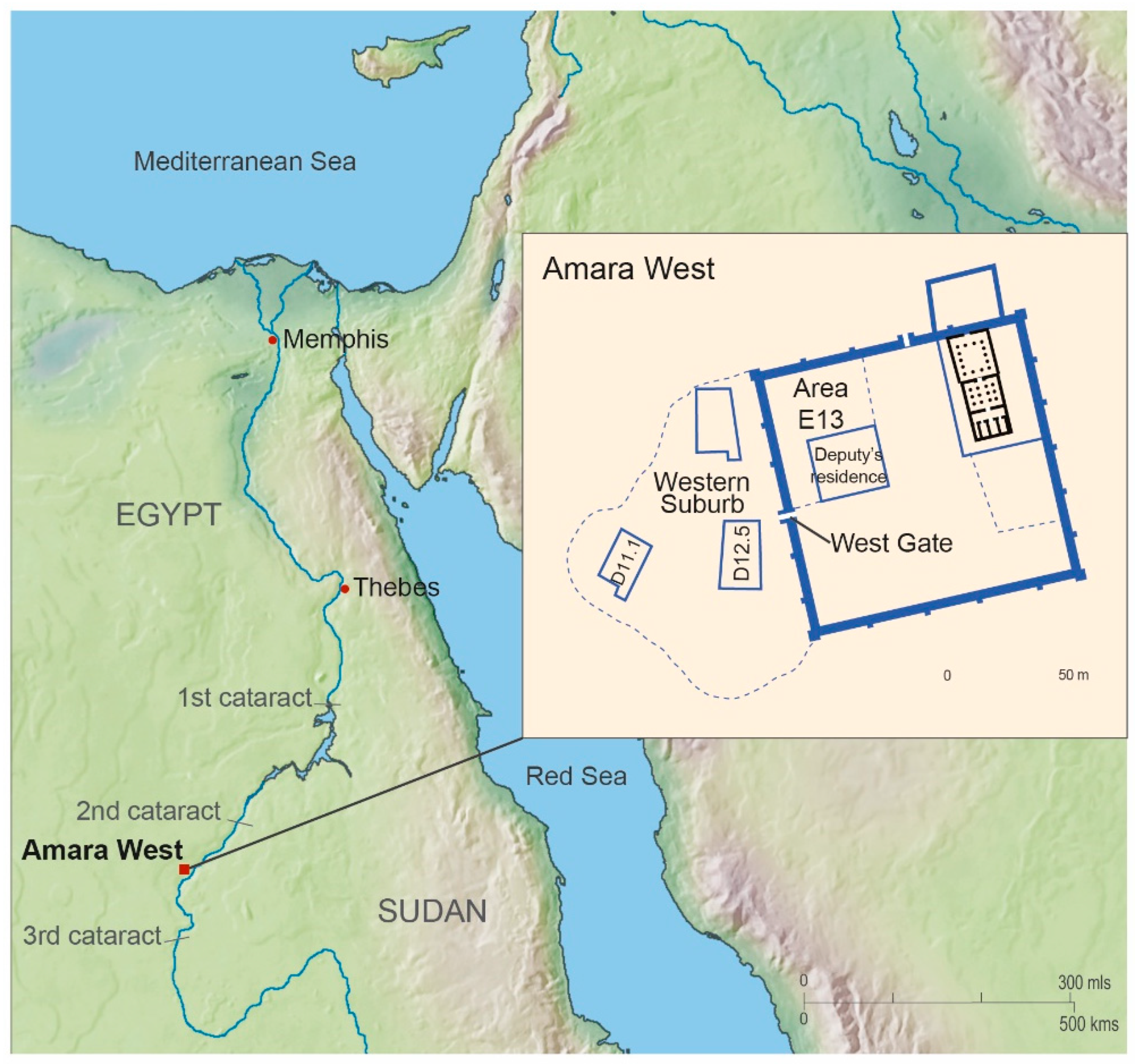
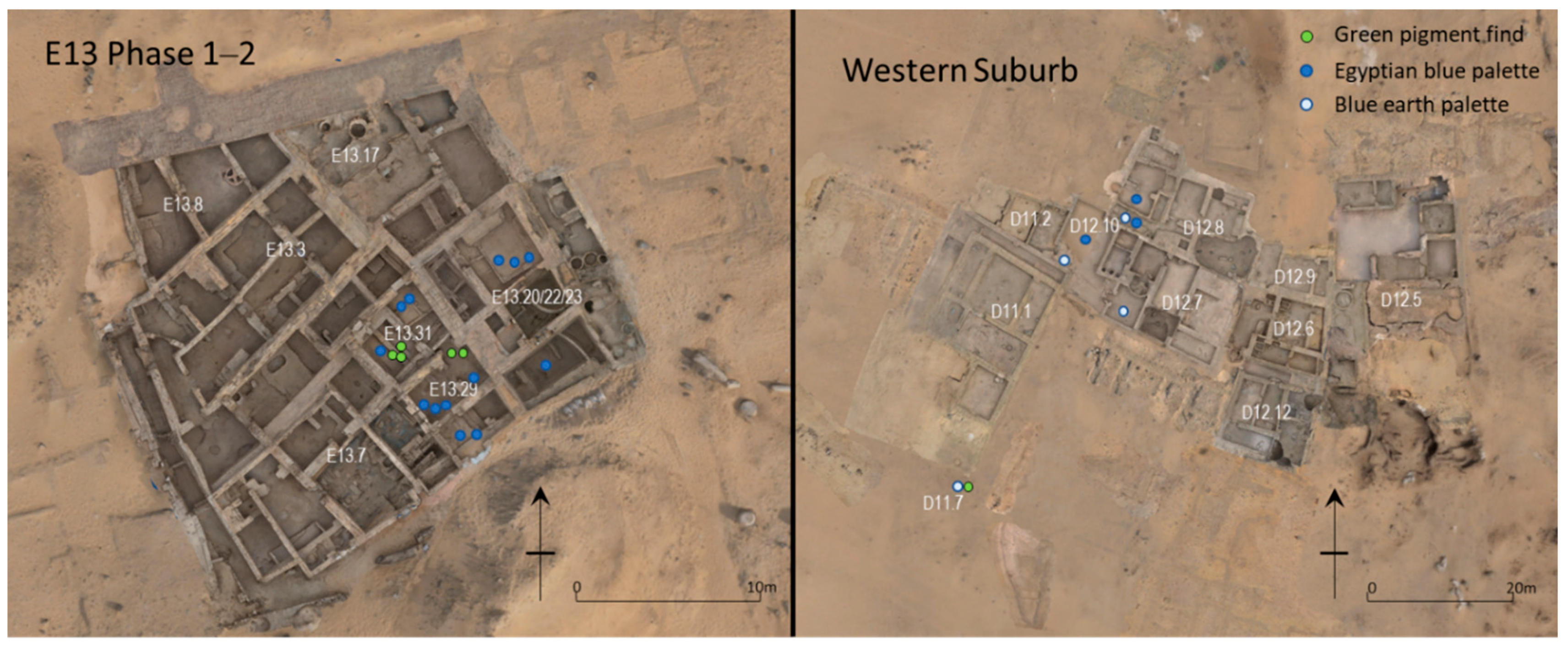
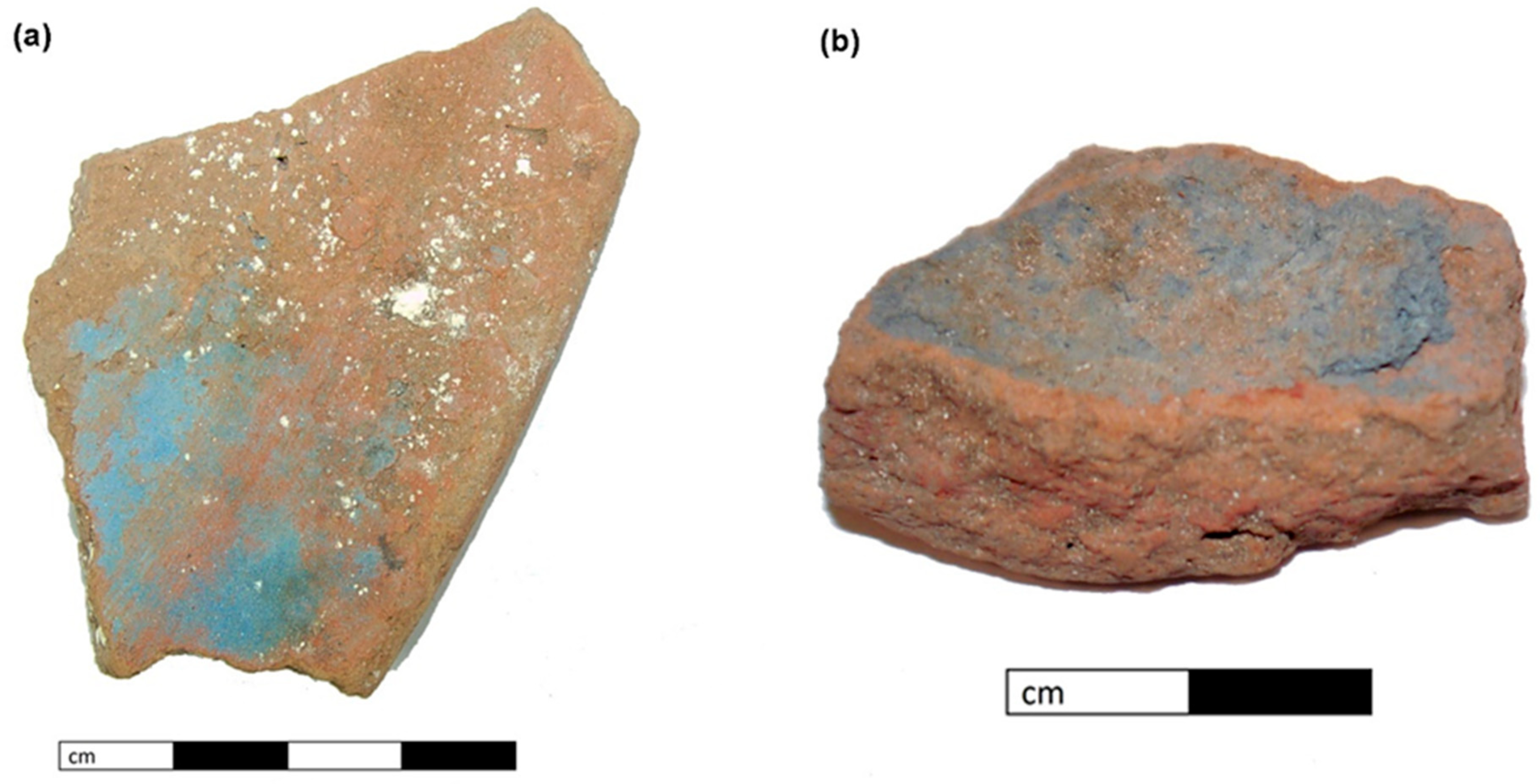
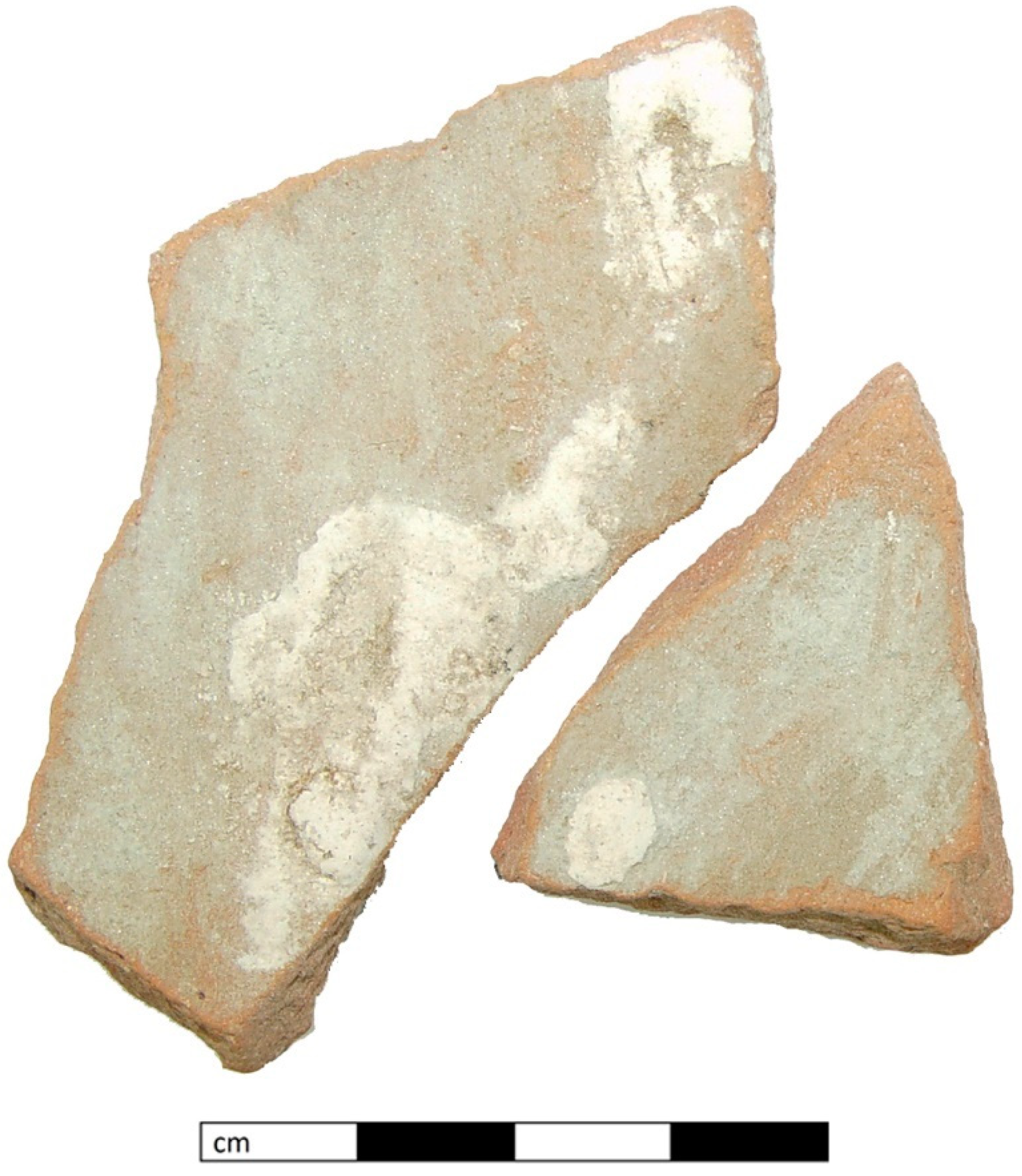


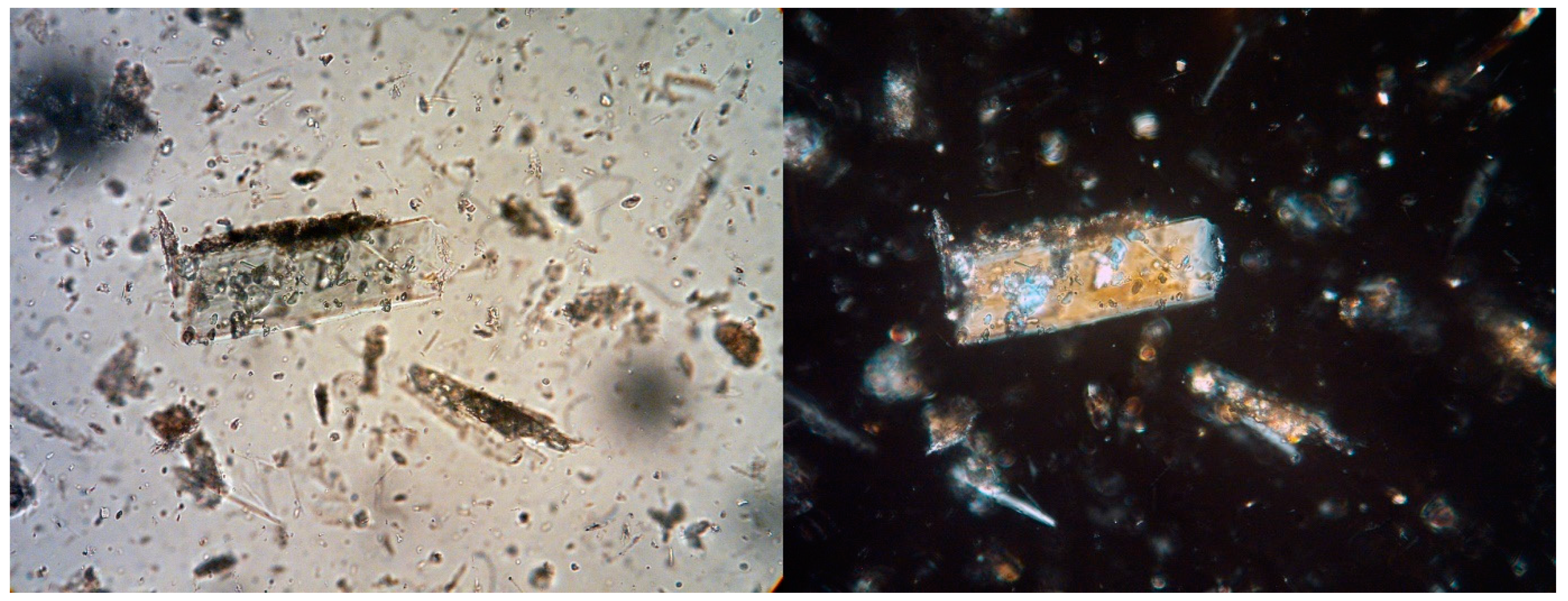
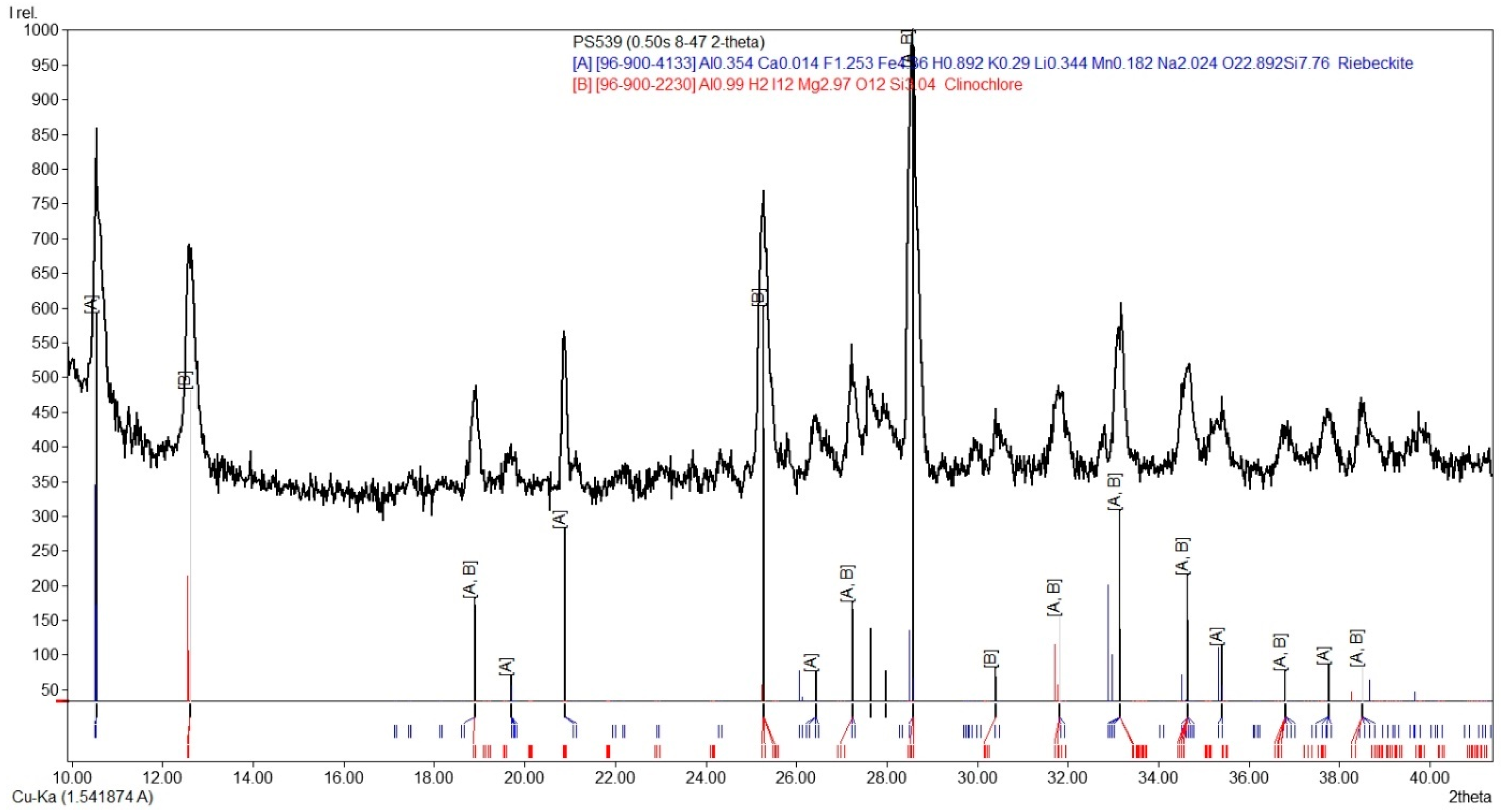


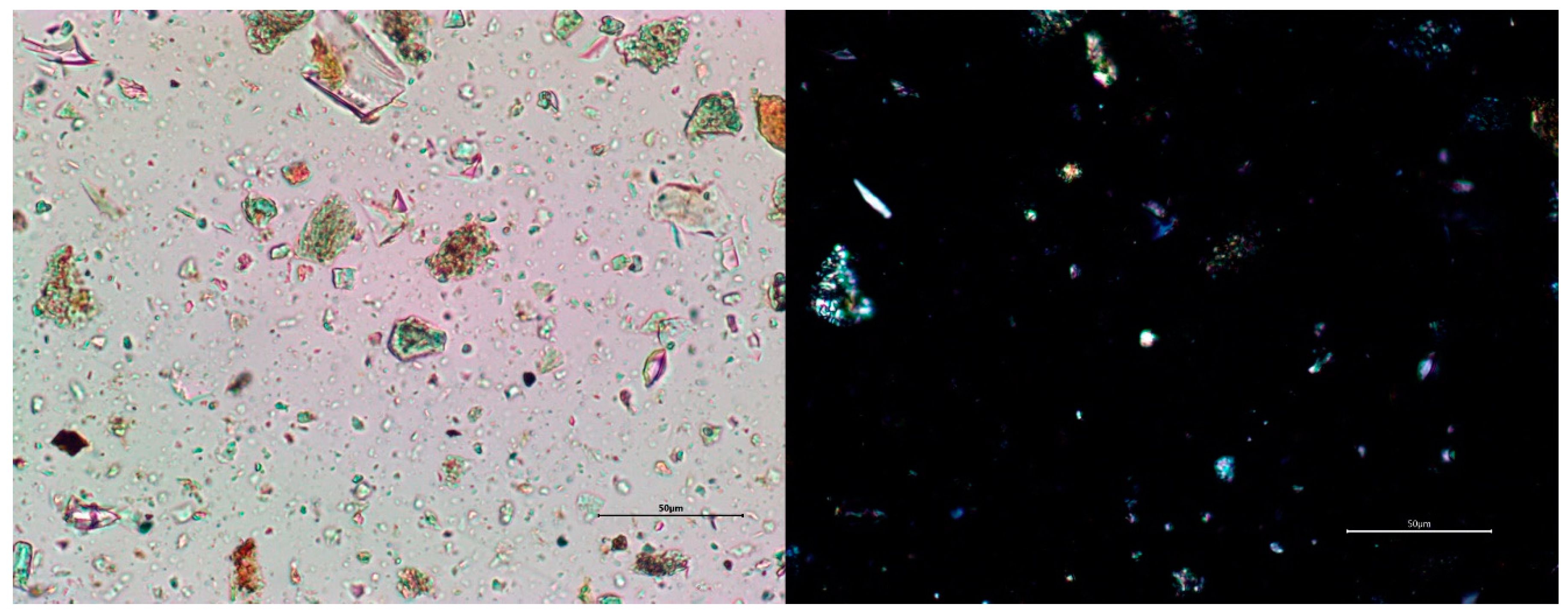
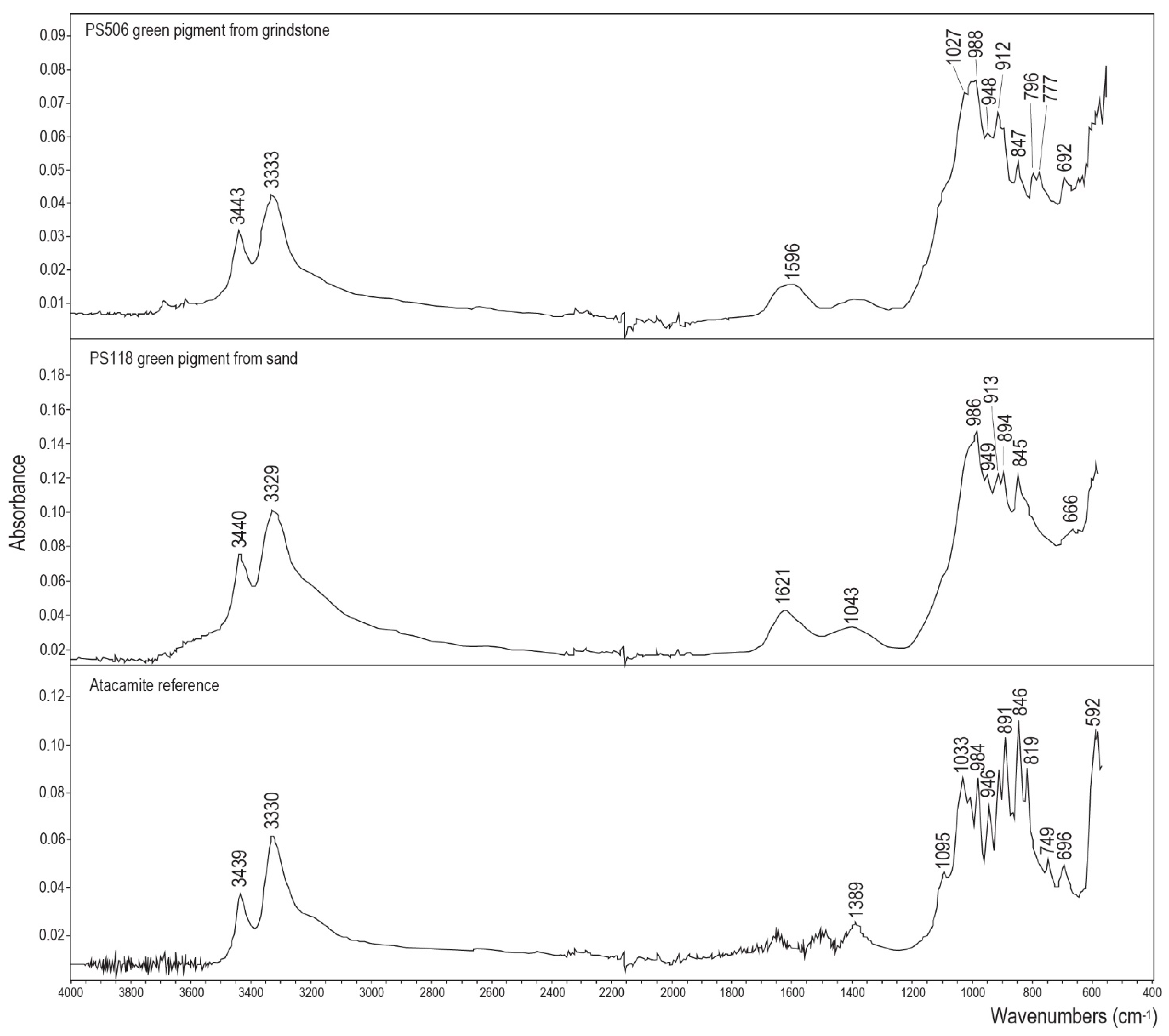
| Element | Wt.% Oxide | Atomic% | Relative Standard Deviation | Ratio to Cu Atomic % |
|---|---|---|---|---|
| Si | 67 | 25 | 0.66 | 4 |
| Ca | 14 | 6 | 1.26 | 1 |
| Cu | 19 | 6 | 2.01 | 1 |
| O | 63 | 0.67 | 10 |
| Find Number | Sample Number | Building | Approx. Date BCE | Analysis | Mineral Identification |
|---|---|---|---|---|---|
| F2644 | PS539 | House D12.7.6 (context 12062), Western Suburb | 1180–1000 | PLM, ATR-FTIR, SEM-EDS, XRD | Blue earth (inc. clinochlore and riebeckite) |
| F15656 | PS860 | House D11.2.4 (context 2716), Western Suburb | 1160–1000 | PLM | Blue earth |
| F16667 | PS865 | Trench D11.7 (context 13569), Western Suburb | 1300–1200 | PLM, ATR-FTIR | Blue earth |
| F15193 | PS893 | House D12.8.8 (context 12891), Western Suburb | 1160–1000 | PLM, ATR-FTIR | Blue earth |
| F7569 | PS287 | Building E13.20.5 (context 10331), walled town | 1200–1180 | PLM | Egyptian blue |
| F7569 | PS324 | Building E13.20.5 (context 10331), walled town | 1200–1180 | PLM | Egyptian blue |
| F7684 | PS537 | Building E13.22.5 (context 10434), walled town | 1210–1190 | PLM | Egyptian blue, gypsum |
| F2600 | PS540 | Building E13.20.1 (context 10324), walled town | 1200–1180 | PLM | Egyptian blue |
| F6223 | PS140 | House E13.29.2 (context 5224), walled town | 1190–1160 | PLM, ATR-FTIR, SEM-EDS | Egyptian blue |
| F6264 | PS417 | House E13.29.2 (context 5261), walled town | 1190–1160 | PLM | Egyptian blue |
| F6223 | PS438 | House E13.7.12/E13.29.2 (context 5224), walled town | 1210–1180 | PLM | Egyptian blue, gypsum |
| F6190 | PS431 | Area E13.31.2 (context 5332), walled town | 1200–1190 | PLM | Egyptian blue |
| F6169 | PS437 | Area E13.31.1 (context 5352), walled town | c. 1200–1180 | PLM | Egyptian blue |
| F6047 | PS418 | Area E13.29.1 (context 5219), walled town | c. 1180–1160 | PLM | Egyptian blue |
| F6147 | PS132 | Area E13.29.4 [context 5325], walled town | c. 1200–1180 | PLM, ATR-FTIR, SEM-EDS | Egyptian blue |
| F6474 | PS443 | Area E13.31.1 (context 5336), walled town | c. 1200–1180 | PLM | Egyptian blue |
| F6147 | PS427 | Area E13.29.4 (context 5325), walled town | 1200–1180 | PLM, ATR-FTIR | Egyptian blue, gypsum |
| F6170 | PS127 | House E13.6.4 (context 5341), walled town | 1160–1140 | PLM, ATR-FTIR | Egyptian blue, gypsum |
| F15193 | PS893 | House D12.8.8 (context 12891), Western Suburb | 1160–1000 | ATR-FTIR | Egyptian blue |
| F15020 | PS534 | House D12.8.7 (context 12840), Western Suburb | 1160–1000 | PLM | Egyptian blue |
| F12423 | PS538 | Open area D12.10 (context 12211), Western Suburb | 1140–1000 | PLM | Egyptian blue, calcite |
| Element | wt.% Oxide Region 1. | wt.% Oxide Region 2. |
|---|---|---|
| SiO2 | 37.2 | 27.2 |
| Al2O3 | 7.9 | 19.1 |
| ΣFeO | 16.5 | 25.1 |
| MgO | 11.4 | 14.8 |
| CaO | 7.3 | n.d. |
| Na2O | 0.7 | 0.4 |
| K2O | 0.4 | 0.1 |
| TiO2 | 2.1 | n.d. |
| MnO | 0.3 | n.d. |
| Cr2O3 | n.d. | 0.4 |
| Total as given | 83.8 | 87.1 |
| Find Number | Sample Number | Type of Object | Building | Approx. Date BCE | Analysis | Mineral Identification |
|---|---|---|---|---|---|---|
| F6119 | PS126 | Palette | Area E13.31.2 (context 5331), walled town | 1200–1180 | PLM, ATR-FTIR, SEM-EDS, XRD | Chlorite (penninite), amphibole (actinolite), quartz, calcite |
| F6463 | PS248 | Palette | Area E13.31.2 (context 5346), walled town | 1200–1180 | PLM, ATR-FTIR | Chlorite, amphibole, quartz, calcite |
| F6467 | PS249 | Palette | Area E13.31.2 (context 5334), walled town | 1200–1180 | PLM, ATR-FTIR | Chlorite, amphibole, quartz, calcite |
| F16767 | PS869 | Palette | Trench D11.7 (context 13568), Western Suburb | 1300–1000 | PLM, ATR-FTIR | Egyptian blue, yellow ochre, calcite |
| F6184 | PS506 | Grindstone | Magazine E13.14.1 (context 5361), walled town | 1250–1210 | PLM, ATR-FTIR, SEM-EDS | Copper trihydroxychloride |
| PS118 | Raw pigment on floor beside grindstone F6184 | Magazine E13.14.1 (context 5365), walled town | 1250–1210 | PLM, ATR-FTIR, SEM-EDS | Copper trihydroxychloride |
| Element | wt.% Oxide |
|---|---|
| SiO2 | 24.0 |
| Al2O3 | 16.4 |
| ΣFeO | 18.6 |
| MgO | 13.1 |
| CaO | 0.6 |
| Na2O | n.d. |
| K2O | n.d. |
| TiO2 | n.d. |
| MnO | 0.3 |
| Cr2O3 | n.d. |
| SO2 | 0.6 |
| Total as given | 73.6 |
Publisher’s Note: MDPI stays neutral with regard to jurisdictional claims in published maps and institutional affiliations. |
© 2021 by the authors. Licensee MDPI, Basel, Switzerland. This article is an open access article distributed under the terms and conditions of the Creative Commons Attribution (CC BY) license (https://creativecommons.org/licenses/by/4.0/).
Share and Cite
Fulcher, K.; Siddall, R.; Emmett, T.F.; Spencer, N. Multi-Scale Characterization of Unusual Green and Blue Pigments from the Pharaonic Town of Amara West, Nubia. Heritage 2021, 4, 2563-2579. https://doi.org/10.3390/heritage4030145
Fulcher K, Siddall R, Emmett TF, Spencer N. Multi-Scale Characterization of Unusual Green and Blue Pigments from the Pharaonic Town of Amara West, Nubia. Heritage. 2021; 4(3):2563-2579. https://doi.org/10.3390/heritage4030145
Chicago/Turabian StyleFulcher, Kate, Ruth Siddall, Trevor F. Emmett, and Neal Spencer. 2021. "Multi-Scale Characterization of Unusual Green and Blue Pigments from the Pharaonic Town of Amara West, Nubia" Heritage 4, no. 3: 2563-2579. https://doi.org/10.3390/heritage4030145
APA StyleFulcher, K., Siddall, R., Emmett, T. F., & Spencer, N. (2021). Multi-Scale Characterization of Unusual Green and Blue Pigments from the Pharaonic Town of Amara West, Nubia. Heritage, 4(3), 2563-2579. https://doi.org/10.3390/heritage4030145





